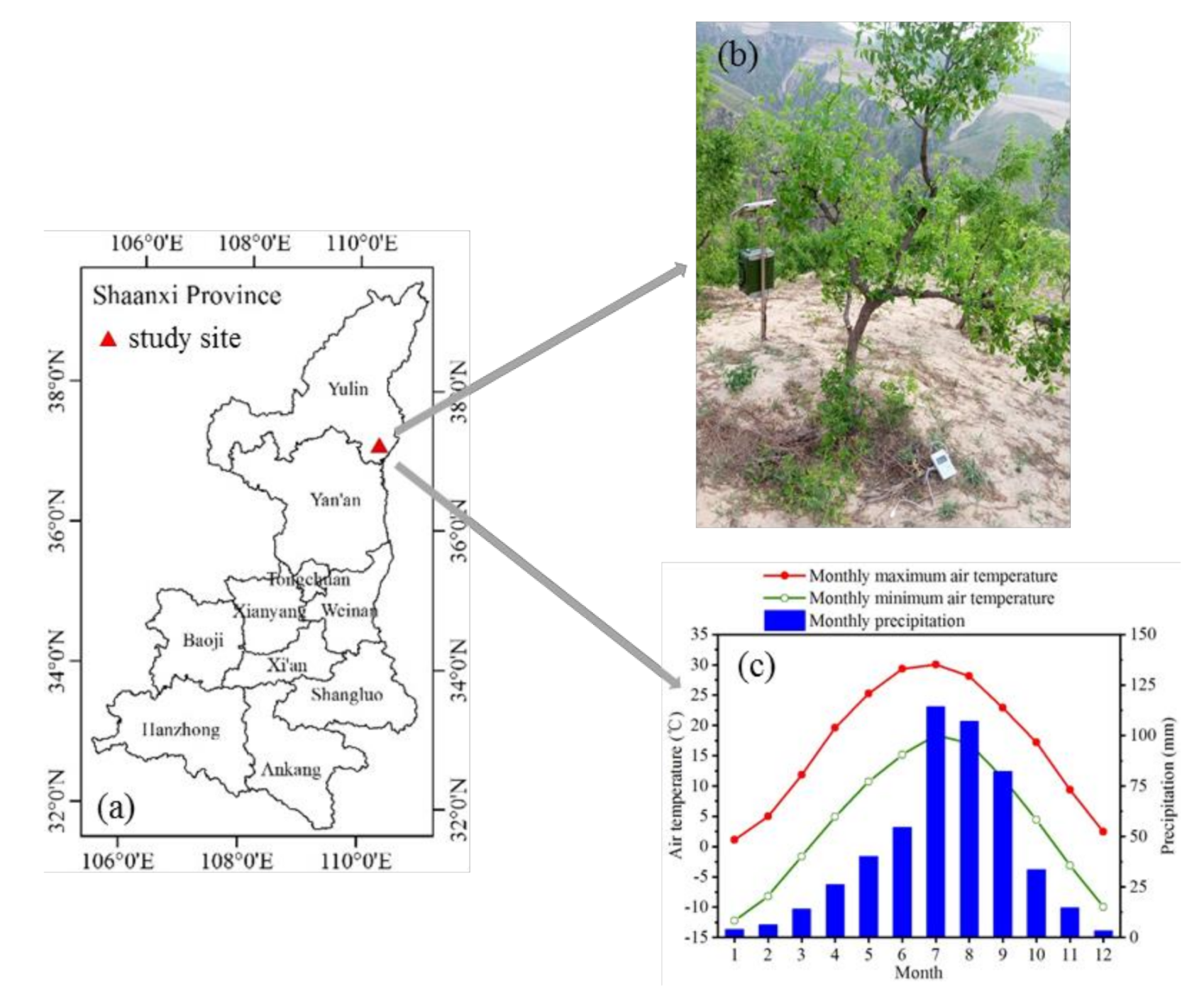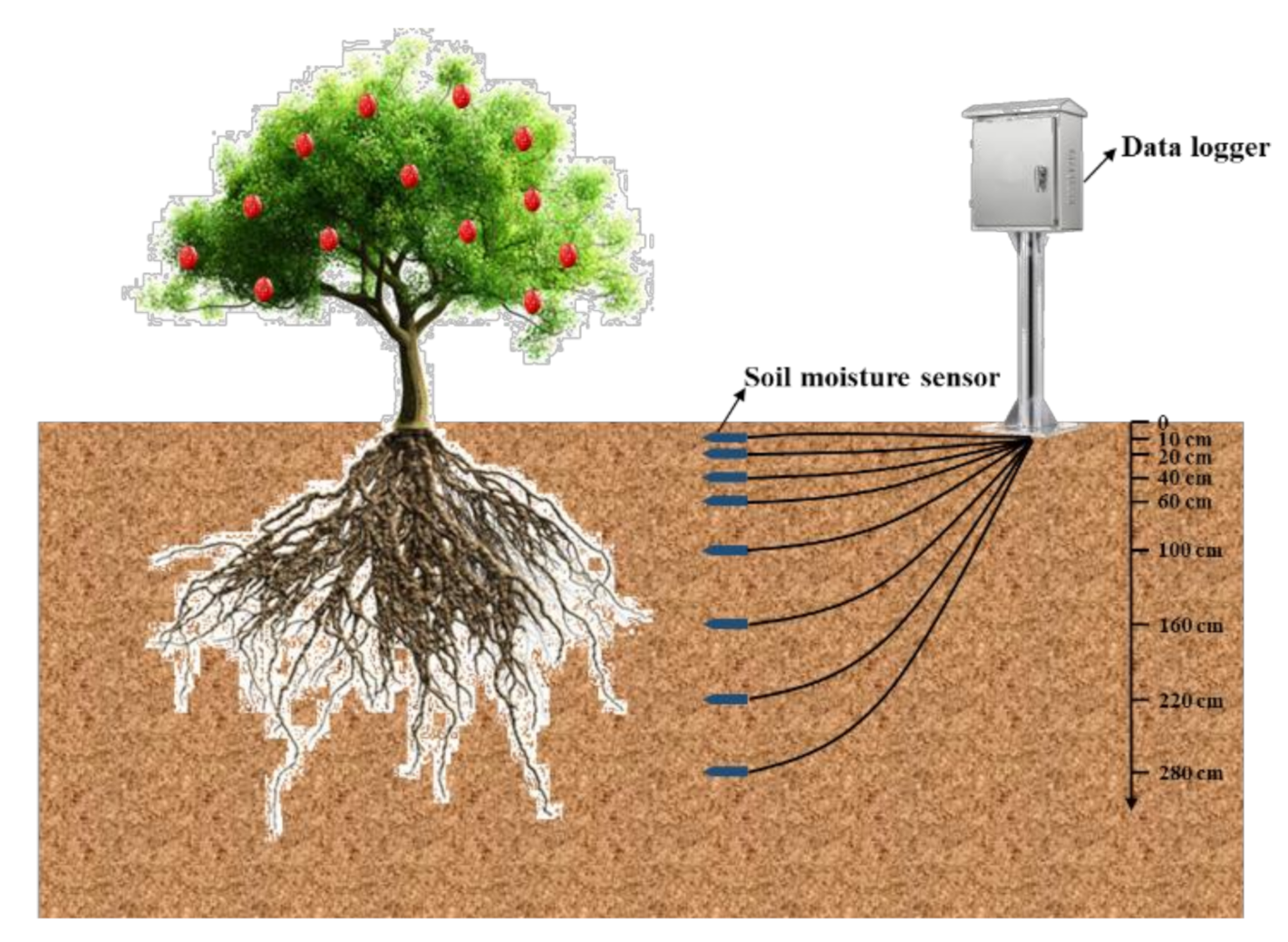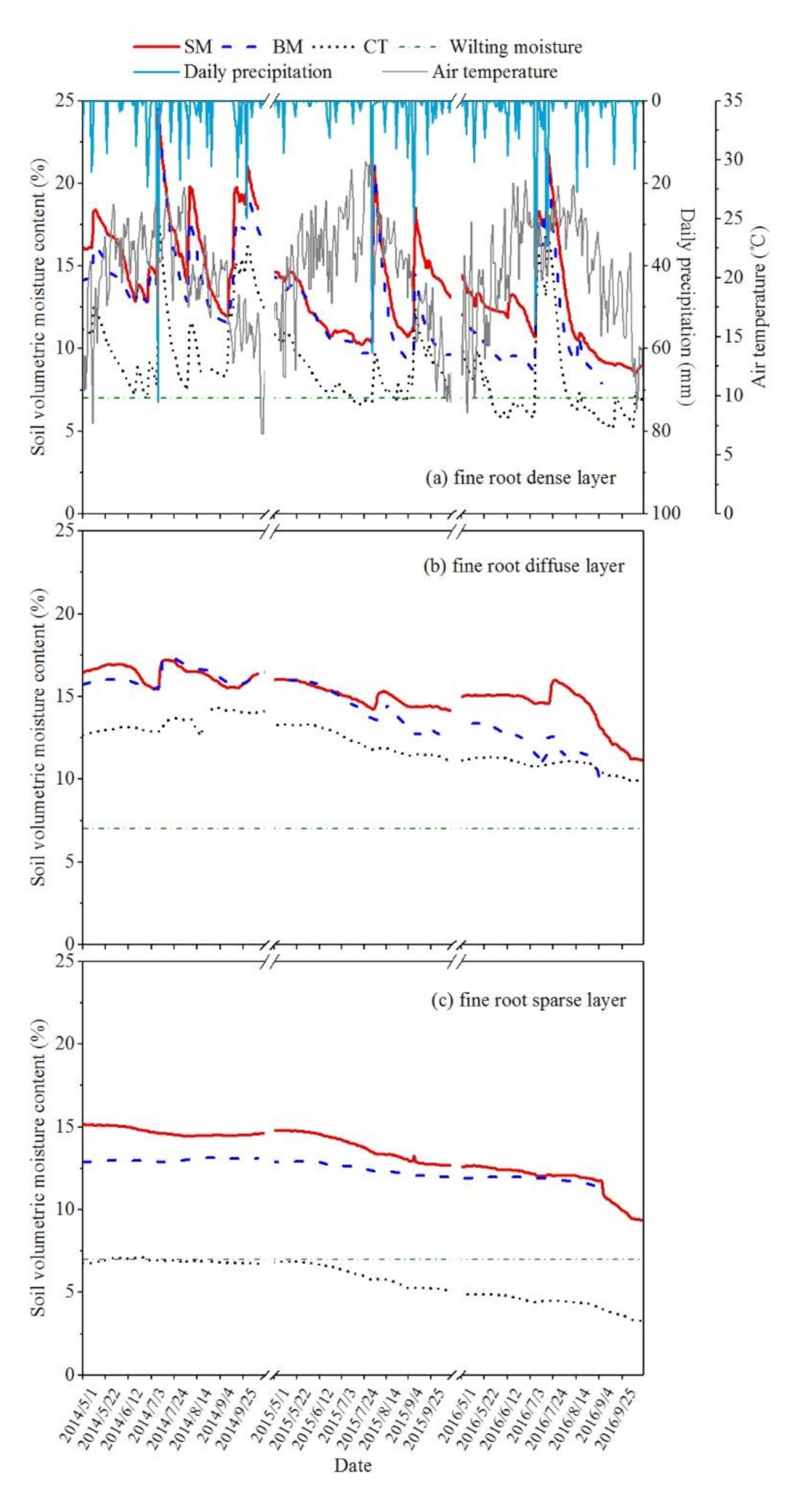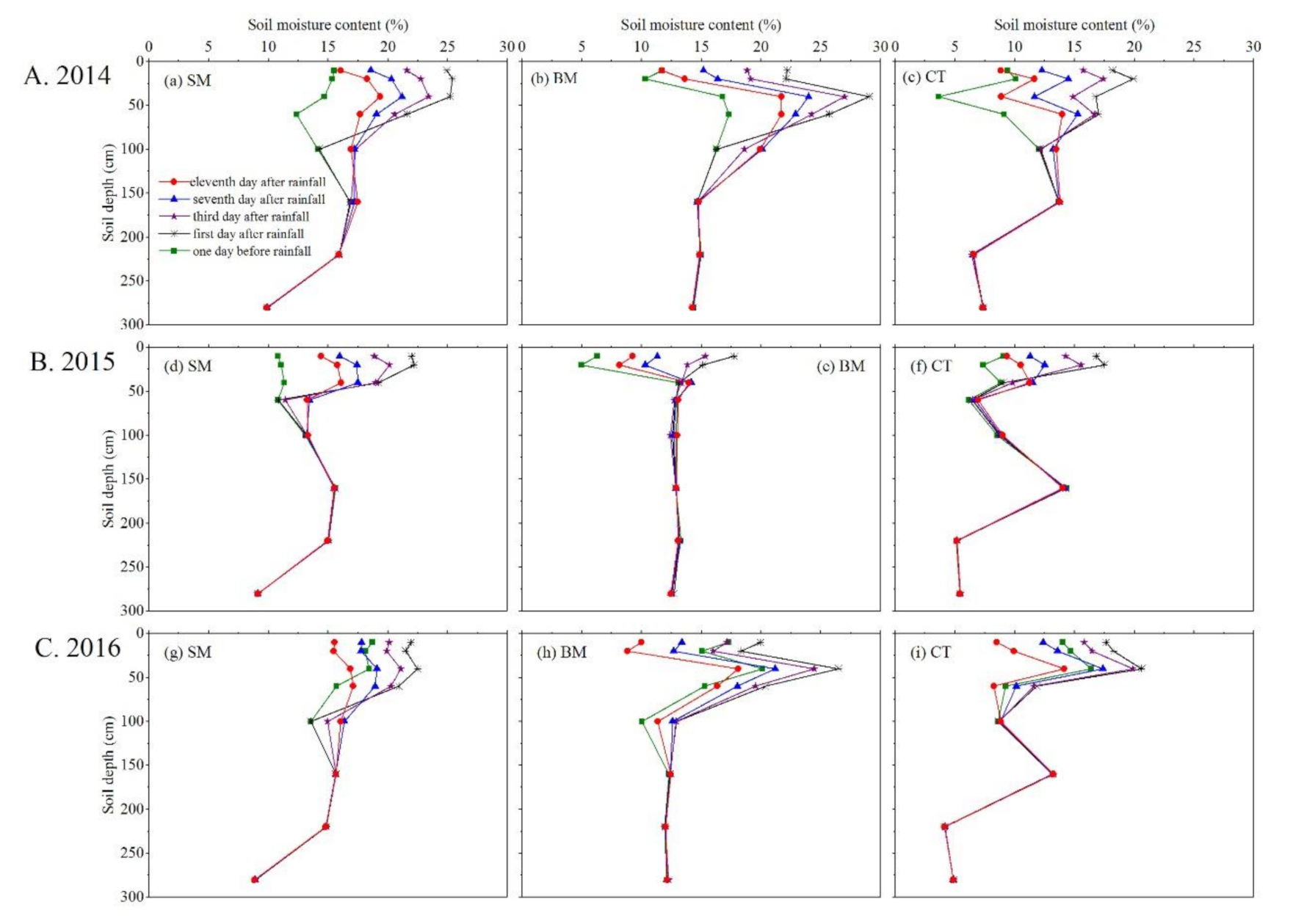Mulching Measures Improve Soil Moisture in Rain-Fed Jujube (Ziziphus jujuba Mill.) Orchards in the Loess Hilly Region of China
Abstract
1. Introduction
2. Materials and Methods
2.1. Study Site
2.2. Experimental Design
2.3. Soil Moisture and Precipitation Measurement
2.4. Data Analysis
3. Results
3.1. Soil Moisture Dynamics in the Rain-Fed Jujube Orchard under Different Mulching Measures
3.2. Soil Water Storage of the Rain-Fed Jujube Orchard under Different Mulching Measures
3.3. Amount and Percentage of the Water Consumption of Jujube Trees under Different Mulching Measures
3.4. Soil Moisture Attenuation Characteristics after Typical Rainfall
4. Discussion
4.1. Soil Moisture Dynamic Changes and Their Attenuation Characteristics after Typical Rainfall in the Rain-Fed Jujube Orchard
4.2. Suggestions for Soil Moisture Management in Rain-Fed Jujube Orchards
5. Conclusions
- (1)
- The 0–60 cm soil layer of the rain-fed jujube orchard was the seasonal fluctuation layer of the soil moisture under straw mulching (SM), jujube branch mulching (BM), and clean tillage (CT) in both the normal precipitation years and the dry year. The 0–60, 60–160, and 160–280 cm soil layers under CT all obtained the lowest soil moisture content in the three experimental years, and the 160–280 cm soil layer formed a perennial low-humidity zone. The soil moisture content of each soil layer under SM and BM was higher than that under CT, and SM had the most obvious effect of improving soil moisture.
- (2)
- SM and BM showed significant soil water storage effects in all of the jujube growth stages in both the normal precipitation years and the dry year, and SM had a better water storage effect than BM.
- (3)
- SM and BM reduced the amount of water consumption in each jujube growth stage. SM and BM increased the water consumption percentage in the emerging, leafing, blossoming and bearing fruit stages in the three experimental years. SM reduced the percentage of water consumption in the fruit spreading growth stage. During the fruit maturity stages in the normal precipitation years, SM and BM both reduced the water consumption percentage, while in the dry year, they increased the percentage of water consumption. The effect of SM on the amount and percentage of water consumption was more obvious than that of BM.
- (4)
- The soil moisture loss rate of CT was significantly higher than that of SM and BM under continuous drought after rainfall. With the extension of drought, the soil moisture loss rate under SM increased slowly, while it increased rapidly under CT.
Author Contributions
Funding
Institutional Review Board Statement
Informed Consent Statement
Data Availability Statement
Acknowledgments
Conflicts of Interest
References
- Yang, L.; Zhang, H.; Chen, L. Identification on threshold and efficiency of rainfall replenishment to soil water in semi-arid loess hilly areas. Sci. China Earth Sci. 2018, 61, 292–301. [Google Scholar] [CrossRef]
- Feng, J.; Wei, W.; Pan, D. Effects of rainfall and terracing-vegetation combinations on water erosion in a loess hilly area, China. J. Environ. Manag. 2020, 261, 110247. [Google Scholar] [CrossRef] [PubMed]
- Song, L.; Liu, W.; Wu, H.; Gao, T.; Hao, W. Characteristics of soil nutrients and their relationship with soil microbial properties in Artemisia sacrorum communities in the loess hilly region. Int. J. Agric. Biol. Eng. 2018, 11, 127–134. [Google Scholar] [CrossRef]
- Yang, K.; Lu, C. Evaluation of land-use change effects on runoff and soil erosion of a hilly basin—The Yanhe River in the Chinese loess plateau. Land Degrad. Dev. 2018, 29, 1211–1221. [Google Scholar] [CrossRef]
- Qin, Y.; Xin, Z.; Yu, X.; Xiao, Y. Influence of vegetation restoration on topsoil organic carbon in a small catchment of the loess hilly region, China. PLoS ONE 2014, 9, e94489. [Google Scholar] [CrossRef]
- Gao, Z.; Shi, W.; Wang, X.; Wang, Y. Non-rainfall water contributions to dryland jujube plantation evapotranspiration in the Hilly Loess Region of China. J. Hydrol. 2020, 583, 124604. [Google Scholar]
- Jin, S.; Wang, Y.; Shi, L.; Guo, X.; Zhang, J. Effects of pruning and mulching measures on annual soil moisture, yield, and water use efficiency in jujube (Ziziphus jujube Mill.) plantations. Glob. Ecol. Conserv. 2018, 15, e00406. [Google Scholar]
- Chen, D.; Wang, Y.; Liu, S.; Wei, X.; Wang, X. Response of relative sap flow to meteorological factors under different soil moisture conditions in rainfed jujube (Ziziphus jujuba Mill.) plantations in semiarid Northwest China. Agric. Water Manag. 2014, 136, 23–33. [Google Scholar] [CrossRef]
- Ling, Q.; Gao, X.; Zhao, X.; Huang, J.; Li, H.; Li, L.; Sun, W.; Wu, P. Soil water effects of agroforestry in rainfed jujube (Ziziphus jujube Mill.) orchards on loess hillslopes in Northwest China. Agric. Ecosyst. Environ. 2017, 247, 343–351. [Google Scholar] [CrossRef]
- Huang, J.; Wang, J.; Zhao, X.; Li, H.; Jing, Z.; Gao, X.; Chen, X.; Wu, P. Simulation study of the impact of permanent groundcover on soil and water changes in jujube orchards on sloping ground. Land Degrad. Dev. 2016, 27, 946–954. [Google Scholar]
- Pearson, C.H.; Holcomb, C.A.; Cooley, A.W.; Murray, J.E. Guidelines for Using Conservation Tillage under Furrow Irrigation; Technical Report Colorado Agricultural Experiment Station, Fruita Research Center: Fruita, CO, USA, 2002; p. TR02-6. [Google Scholar]
- Wasaya, A.; Yasir, T.A.; Ijaz, M.; Ahmad, S. Agronomic Crops; Springer: Singapore, 2019; pp. 73–99. [Google Scholar]
- Mikha, M.M.; Benjamin, J.G.; Vigil, M.F.; Poss, D.J. Manure and tillage use in remediation of eroded land and impacts on soil chemical properties. PLoS ONE 2017, 12, e0175533. [Google Scholar]
- Kader, M.A.; Senge, M.; Mojid, M.A.; Onishi, T.; Ito, K. Effects of plastic-hole mulching on effective rainfall and readily available soil moisture under soybean (Glycine max) cultivation. Paddy Water Environ. 2017, 15, 659–668. [Google Scholar] [CrossRef]
- Jafari, M.; Haghighi, J.A.P.; Zare, H. Mulching impact on plant growth and production of rainfed fig orchards under drought conditions. J. Food Agric. Environ. 2012, 10, 428–433. [Google Scholar]
- Adak, T.; Kumar, K.; Singha, A.; Shukla, S.K.; Singh, V.K. Assessing soil characteristics and guava orchard productivity as influenced by organic and inorganic substrates. J. Anim. Plant Sci. 2014, 24, 1157–1165. [Google Scholar]
- Sofo, A.; Ciarfaglia, A.; Scopa, A.; Camele, I.; Curci, M.; Crecchio, C.; Xiloyannis, C.; Palese, A.M. Soil microbial diversity and activity in a Mediterranean olive orchard using sustainable agricultural practices. Soil Use Manag. 2014, 30, 160–167. [Google Scholar]
- Lordan Sanahuja, J.; Pascual Roca, M.; Villar Mir, J.M.; Fonseca Salcedo, F.; Papió, J.; Montilla, V.; Rufat i Lamarca, J. Use of organic mulch to enhance water-use efficiency and peach production under limiting soil conditions in a three-year-old orchard. Span. J. Agric. Res. 2015, 13, e0904. [Google Scholar] [CrossRef]
- Almagro, M.; Garcia-Franco, N.; Martínez-Mena, M. The potential of reducing tillage frequency and incorporating plant residues as a strategy for climate change mitigation in semiarid Mediterranean agroecosystems. Agric. Ecosyst. Environ. 2017, 246, 210–220. [Google Scholar]
- Joolka, N.K.; Chand, R.; Sharma, S. Impact of water conservation techniques and herbicidal treatments on yield and quality of Delicious apple under water stress conditions. Indian J. Hortic. 2008, 65, 12–15. [Google Scholar]
- Ojasvi, P.R.; Goyal, R.K.; Gupta, J.P. The micro-catchment water harvesting technique for the plantation of jujube (Zizyphus mauritiana) in an agroforestry system under arid conditions. Agric. Water Manag. 1999, 41, 139–147. [Google Scholar]
- Hao, M.; Wei, X.; Dang, T. Effect of long-term applying zinc fertilizer on wheat yield and content of zinc in dryland. Plant Nutr. Fertil. Sci. 2003, 9, 377–380, (in Chinese with English abstract). [Google Scholar]
- Li, L.; Gao, X.; Wu, P.; Zhao, X.; Li, H.; Ling, Q.; Sun, W. Soil water content and root patterns in a rain-fed jujube plantation across stand ages on the loess plateau of China. Land Degrad. Dev. 2017, 28, 207–216. [Google Scholar] [CrossRef]
- Akhtar, K.; Wang, W.; Khan, A.; Ren, G.; Afridi, M.Z.; Feng, Y.; Yang, G. Wheat straw mulching with fertilizer nitrogen: An approach for improving soil water storage and maize crop productivity. Plant Soil Environ. 2018, 64, 330–337. [Google Scholar]
- Ritchie, J.T. A user-orientated model of the soil water balance in wheat. In Wheat Growth and Modelling; Day, W., Atkin, R.K., Eds.; Springer: Boston, MA, USA, 1985; pp. 293–305. [Google Scholar]
- Han, S.; Li, Y.; Zhang, X.; Shi, Z. The regional dynamic characteristics of soil water on the Loess Plateau. Res. Soil Water Conserv. 1989, 1, 161–167, (in Chinese with English abstract). [Google Scholar]
- Huang, L.; Gao, Y.; Qiu, X.; Li, X.; Shen, X.; Sun, J.; Gong, W.; Duan, A. Effects of irrigation amount and stage on yield and water consumption of different winter wheat cultivars. Trans. Chin. Soc. Agric. Eng. 2013, 29, 99–108, (in Chinese with English abstract). [Google Scholar]
- Huang, Z.; Cao, Y.; Ouyang, Z.; Tu, N.; Zheng, H. Dynamics of soil water under Vernicia fordii plantation in hilly red soil region of Southern China. Chin. J. Appl. Ecol. 2007, 18, 241–246. [Google Scholar]
- Ma, Y.; Zheng, G.; Zhou, J.; Zheng, Q. Effects of different irrigation thresholds on the growth and water use efficiency of jujube trees. Agric. Res. Arid Areas 2020, 38, 58–61, (in Chinese with English abstract). [Google Scholar]
- Zribi, W.; Aragüés, R.; Medina, E.; Faci, J.M. Efficiency of inorganic and organic mulching materials for soil evaporation control. Soil Tillage Res. 2015, 148, 40–45. [Google Scholar] [CrossRef]
- Saglam, M.; Sintim, H.Y.; Bary, A.I.; Miles, C.A.; Ghimire, S.; Inglis, D.A.; Flury, M. Modeling the effect of biodegradable paper and plastic mulch on soil moisture dynamics. Agric. Water Manag. 2017, 193, 240–250. [Google Scholar] [CrossRef]
- Srivastava, R.J.; Kumar, A.; Prasad, K. Studies on soil moisture variations under eucalyptus plantation. Studies 2003, 500, B2. [Google Scholar]
- Berthrong, S.T.; Jobbágy, E.G.; Jackson, R.B. A global meta-analysis of soil exchangeable cations, pH, carbon, and nitrogen with afforestation. Ecol. Appl. 2009, 19, 2228–2241. [Google Scholar]
- Pan, D.; Zhao, X.; Gao, X.; Song, Y.; Dyck, M.; Wu, P.; Li, Y.; Ma, L. Application rate influences the soil and water conservation effectiveness of mulching with chipped branches. Soil Sci. Soc. Am. J. 2018, 82, 447–454. [Google Scholar]
- Wang, X.; Gao, Z.; Wang, Y.; Nie, Z.; Jin, S.; Dong, J. Effects of pruning and mulching on soil desiccation remediation in rain-fed jujube plantation in the semi-arid loess hilly gull region. Sci. Silvae Sin. 2018, 54, 24–30, (in Chinese with English abstract). [Google Scholar]
- Blanco-Canqui, H.; Lal, R. Impacts of long-term wheat straw management on soil hydraulic properties under no-tillage. Soil Sci. Soc. Am. J. 2007, 71, 1166–1173. [Google Scholar] [CrossRef]
- Gholami, L.; Banasik, K.; Sadeghi, S.H.; Darvishan, A.K.; Hejduk, L. Effectiveness of straw mulch on infiltration, splash erosion, runoff and sediment in laboratory conditions. J. Water Land Dev. 2014, 22, 51–60. [Google Scholar] [CrossRef]






| Soil Layer | Bulk Density | Soil Particle Composition a | Ksat b | θs c | θ33kPa d | θ1500kPa e | ||
|---|---|---|---|---|---|---|---|---|
| (cm) | (g∙cm−3) | Sand (%) | Silt (%) | Clay (%) | (mm∙min–1) | (cm3∙cm–3) | (cm3∙cm–3) | (cm3∙cm–3) |
| 0–20 | 1.27 | 19.1 | 64.7 | 16.2 | 1.21 | 50.4 | 27.5 | 6.6 |
| 20–40 | 1.31 | 18.8 | 64.8 | 16.4 | 1.28 | 50.8 | 27.1 | 7.2 |
| 40–60 | 1.31 | 17.9 | 63.1 | 19.0 | 1.16 | 53.1 | 28.4 | 7.1 |
| 60–80 | 1.45 | 17.4 | 64.5 | 18.1 | 0.91 | 52.8 | 28.1 | 7.3 |
| 80–100 | 1.37 | 18.7 | 62.8 | 18.5 | 0.85 | 52.3 | 27.8 | 8.1 |
| 100–120 | 1.40 | 16.5 | 62.5 | 21.0 | 0.82 | 57.1 | 30.4 | 9.5 |
| 120–140 | 1.37 | 16.1 | 63.2 | 20.7 | 0.92 | 55.8 | 30.2 | 9.2 |
| 140–160 | 1.41 | 16.8 | 62.9 | 20.3 | 0.86 | 56.4 | 29.0 | 7.9 |
| 160–180 | 1.46 | 16.2 | 64.1 | 19.7 | 0.94 | 55.4 | 29.2 | 8.8 |
| Year | Mulching Treatment | Emerging and Leafing Stage | Fruit Spreading Growth Stage | Fruit Maturity Stage | Whole Growth Period | |||
|---|---|---|---|---|---|---|---|---|
| ET(mm) | CP(%) | ET(mm) | CP(%) | ET(mm) | CP(%) | ET(mm) | ||
| 2014 | SM | 60.1 | 19.8 | 92.8 | 30.6 | 52.3 | 17.3 | 302.9 |
| BM | 61.9 | 17.1 | 135.1 | 37.3 | 59.5 | 16.4 | 362.4 | |
| CT | 62.8 | 15.8 | 144.7 | 36.4 | 80.1 | 20.2 | 397.2 | |
| 2015 | SM | 51.6 | 22.5 | 80.4 | 35.0 | 52.2 | 22.7 | 229.7 |
| BM | 53.7 | 20.7 | 101.7 | 39.2 | 55.2 | 21.3 | 259.4 | |
| CT | 55.3 | 19.0 | 124.2 | 42.8 | 56.5 | 19.5 | 290.5 | |
| 2016 | SM | 76.5 | 22.6 | 137.2 | 40.5 | 48.8 | 14.4 | 338.6 |
| BM | 88.5 | - a | 178.1 | - | - | - | - | |
| CT | 88.7 | 19.3 | 202.7 | 44.1 | 69.6 | 15.1 | 459.9 | |
Publisher’s Note: MDPI stays neutral with regard to jurisdictional claims in published maps and institutional affiliations. |
© 2021 by the authors. Licensee MDPI, Basel, Switzerland. This article is an open access article distributed under the terms and conditions of the Creative Commons Attribution (CC BY) license (http://creativecommons.org/licenses/by/4.0/).
Share and Cite
Tang, M.; Li, H.; Zhang, C.; Zhao, X.; Gao, X.; Wu, P. Mulching Measures Improve Soil Moisture in Rain-Fed Jujube (Ziziphus jujuba Mill.) Orchards in the Loess Hilly Region of China. Sustainability 2021, 13, 610. https://doi.org/10.3390/su13020610
Tang M, Li H, Zhang C, Zhao X, Gao X, Wu P. Mulching Measures Improve Soil Moisture in Rain-Fed Jujube (Ziziphus jujuba Mill.) Orchards in the Loess Hilly Region of China. Sustainability. 2021; 13(2):610. https://doi.org/10.3390/su13020610
Chicago/Turabian StyleTang, Min, Hongchen Li, Chao Zhang, Xining Zhao, Xiaodong Gao, and Pute Wu. 2021. "Mulching Measures Improve Soil Moisture in Rain-Fed Jujube (Ziziphus jujuba Mill.) Orchards in the Loess Hilly Region of China" Sustainability 13, no. 2: 610. https://doi.org/10.3390/su13020610
APA StyleTang, M., Li, H., Zhang, C., Zhao, X., Gao, X., & Wu, P. (2021). Mulching Measures Improve Soil Moisture in Rain-Fed Jujube (Ziziphus jujuba Mill.) Orchards in the Loess Hilly Region of China. Sustainability, 13(2), 610. https://doi.org/10.3390/su13020610





